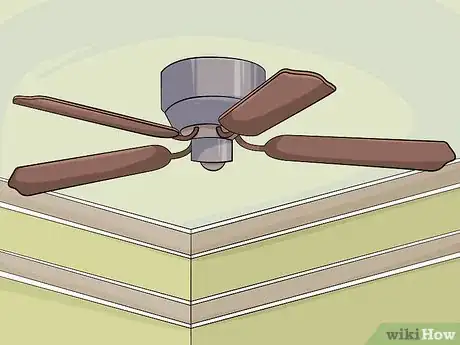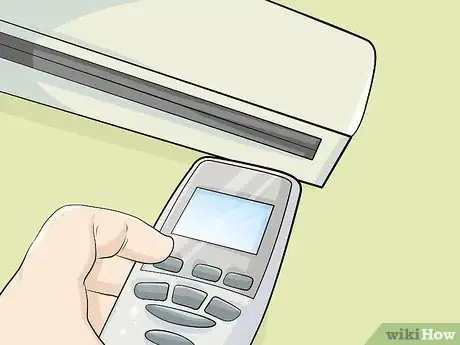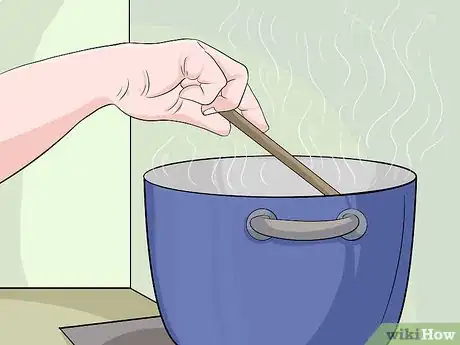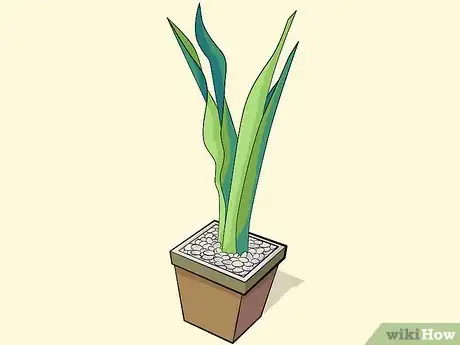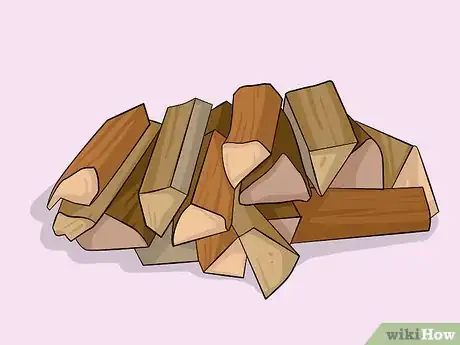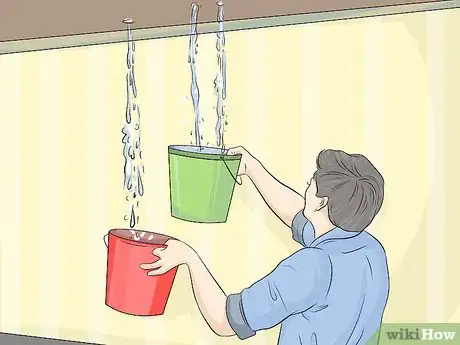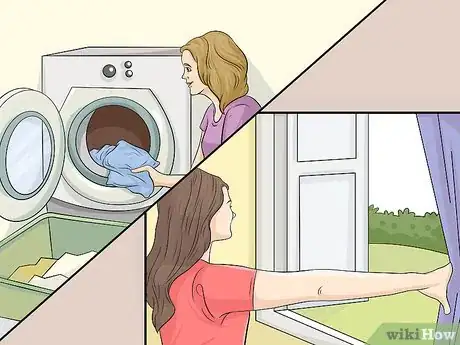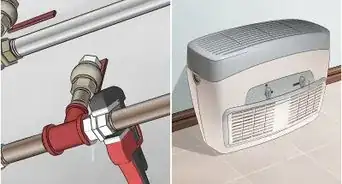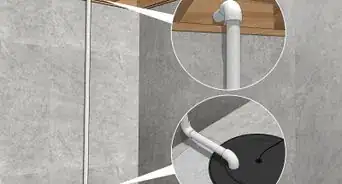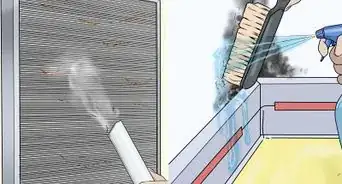This article was co-authored by Victor Belavus. Victor Belavus is an Air Conditioning Specialist and the Owner of 212 HVAC, an air condition repair and installation company based in Brooklyn, New York. In addition to HVAC and air conditioning units, Victor also specializes in furnace repair and air duct cleaning. He has over 10 years of experience working with HVAC systems.
This article has been viewed 63,817 times.
A humid home can be irritating and uncomfortable, especially in the warmer months. Luckily, you have many options to reduce humidity in your living space. Appliances like dehumidifiers can help remove moisture from the air. You can also adjust how you shower and cook to reduce humidity. Certain things, like plants, may increase humidity in your home and should be removed.
Steps
Using Appliances
-
1Invest in a humidity monitor. Pick up a humidity monitor at a department store or buy one online. You can keep this in your home to monitor humidity levels, as this will help you figure out which activities and appliances raise humidity in your home. For example, if humidity levels sky rocket when you're cooking, make a habit of opening windows and turning on fans when you're cooking.
-
2Run a de-humidifier. A de-humidifier is one of the easiest ways to reduce humidity in your home. You can buy a de-humidifier online or pick one up at a local department store.[1]
- De-humidifiers come in different sizes to accommodate varying living spaces. If you live in a smaller home, you can buy a small portable de-humidifier.
- If you live in a larger home, you can buy a larger de-humidifier that's similar to a home fridge or air conditioner.
Advertisement -
3Use fans. If you have fans, keeping them on throughout the day can help de-humidify your home. Proper ventilation helps keep the air from becoming stale and humid.
- Position fans near open windows. This helps increase air flow to your home, decreasing levels of humidity.
-
4Purchase moisture-absorbing materials. There are many types of absorbent crystals you can purchase online or at a department store that reduce humidity in the home. Things like rock salt, DriZair, and Damprid can all be used to dehumidify your living space.[2]
- To use rock salt, you need to drill inside one bucket. Then, put this bucket inside one without holes and pour in the rock salt. Place it in the area you want to dehumidify.
- Damprid comes in a powder of package that can be hung or spread throughout your home to reduce humidity.
- DriZair is usually placed in a colander filled with a vinyl screen. Leave the colander in a room to dehumidify.
-
5Turn on your air conditioner. If you have an air conditioner, run it. Most modern air conditioners both de-humidify and cool the air.[3]
- Some air conditioners may have a de-humidify setting. If your AC comes equipped with such a setting, use it.
-
6Run a space heater. If your home is humid during cooler months, a space heater can actually help. Warming a room can help reduce humidity if the warmth comes from a dry heat source, like a space heater.[4]
Altering Your Daily Habits
-
1Take shorter, colder showers. If your bathroom is very humid, alter your showering routine. The moisture in the air after a hot shower can cause humidity. Strive for quicker showers with warm water to de-humidify your bathroom.[5]
-
2Reduce steam when cooking. Steam from cooking can contribute to household humidity. To reduce steam when cooking, cover your food while it cooks. If you have exhaust fans in your oven, turn them on to remove steam from the air. If you have a slow cooker, use this instead of an oven or stove whenever possible.[6]
- If you don't have exhaust fans, crack open the windows when you cook.
-
3Open your windows when humidity drops outside. Do not keep your windows closed at all times. Purchase a humidity monitor and keep it on in your home. Check humidity levels outdoors online. If you humidity is lower outside, open your windows for a few hours to air out your home.[7]
-
4Make a habit of using vent fans. Many people have vent fans in the bathroom and kitchen but neglect to turn them on. Make a habit of turning on vent fans each time you cook or shower. This should help reduce the overall humidity levels in your home.[8]
Reducing Causes of Humidity
-
1Limit indoor plants. While indoor plants can be an attractive accessory, keeping them in your home can raise humidity levels. Keep indoor plants to a minimum as this will bring down humidity levels.
- If you have a balcony, consider moving indoor plants outside.
-
2Keep firewood outside. Firewood can absorb moisture easily, raising humidity levels in your home. If you have a fireplace, find a safe place outdoors to keep your firewood. Keeping moisture absorbing materials outdoors keeps your home free of humidity.[9]
-
3Treat water damage. If you notice signs of water damage, such as leaks or water rings, contact a professional right away for assessment. Not only can water damage increase humidity, it can cause structural damage to your home. Water damage should be dealt with immediately to keep your home safe and dry.[10]
-
4Open windows when using washers and dryers. If you have a washer or dryer in your home, these can easily spike humidity levels when you're using them. If possible, keep windows open when you're using a washer or dryer. You can also move washers and dryers to areas of your home where you don't frequently hang out, like a basement or enclosed porch.
Expert Q&A
Did you know you can get expert answers for this article?
Unlock expert answers by supporting wikiHow
-
QuestionCan I use the air conditioning to dehumidify the air?
 Victor BelavusVictor Belavus is an Air Conditioning Specialist and the Owner of 212 HVAC, an air condition repair and installation company based in Brooklyn, New York. In addition to HVAC and air conditioning units, Victor also specializes in furnace repair and air duct cleaning. He has over 10 years of experience working with HVAC systems.
Victor BelavusVictor Belavus is an Air Conditioning Specialist and the Owner of 212 HVAC, an air condition repair and installation company based in Brooklyn, New York. In addition to HVAC and air conditioning units, Victor also specializes in furnace repair and air duct cleaning. He has over 10 years of experience working with HVAC systems.
Air Conditioning Specialist
References
- ↑ Victor Belavus. Air Conditioning Specialist. Expert Interview. 6 May 2020.
- ↑ https://dengarden.com/cleaning/Ways-to-Dehumidify-Your-Greenhouse-andor-Home-Environment
- ↑ https://www.hunker.com/12002792/how-to-dehumidify-a-room-without-a-dehumidifier
- ↑ https://www.hunker.com/12002792/how-to-dehumidify-a-room-without-a-dehumidifier
- ↑ http://www.criticalcactus.com/reduce-home-humidity/
- ↑ http://www.criticalcactus.com/reduce-home-humidity/
- ↑ https://www.hunker.com/12002792/how-to-dehumidify-a-room-without-a-dehumidifier
- ↑ http://www.criticalcactus.com/reduce-home-humidity/
- ↑ http://www.criticalcactus.com/reduce-home-humidity/
About This Article
A humid house can be uncomfortable to live in, but luckily there are several ways you can reduce the humidity in your space. If you have fans, keep them on during the day. Try to position them near open windows to increase the airflow, which will decrease the humidity. Your bathroom can be the source of a lot of humidity, so try to take faster, cooler showers. Steam from cooking can also add to your household humidity, so cover your food when it’s cooking, turn on the exhaust fans in your oven, or crack a window to remove the moisture. Another way to reduce humidity in your home is to use a dehumidifier, which you can buy online or pick up at a local department store. Dehumidifiers come in different sizes, so pick one that will best accommodate your space. To learn how to use a humidity monitor to help decrease the moisture in your house, keep reading!



